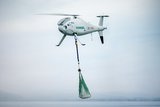Northrop Grumman Firebird demonstrates capabilities during Empire Challenge
The Northrop Grumman Corporation Firebird intelligence-gathering air system successfully used three different high-definition video sensors and an electronics support payload all at the same time – a future capability sought by the U.S. military that's available today.
The flight marks the first time three electro-optical, infrared sensors have been used simultaneously with a fourth payload on an aircraft. This capability was proven on May 20 at Fort Huachuca, Ariz., with additional missions through June 3 as part of the U.S. Joint Forces Command's Empire Challenge 2011 exercise.
"Firebird's universal interface is what makes this all possible," said Rick Crooks, director of special projects and Firebird program manager for Northrop Grumman Aerospace Systems. "It's very similar to plugging a memory stick into a computer – it's automatically recognized without needing to load new software. With this 'plug-and-play' technology we can place many different sensors on Firebird and operate them in a matter of minutes."
Crooks explained that this capability is important to warfighters because it significantly reduces the time needed to replace sensors so they can ready Firebird quickly for different missions. The flight team can install the three high-definition full-motion video (HD FMV) sensors along with a communications payload in less than an hour.
During Empire Challenge, the Firebird team also showed how real-time HD video could be sent to different locations including a ground control station, remote terminals, a tablet computer and a cellular phone. Control of the sensors was done independently through the ground station and remote terminals.
"Not only can soldiers on the ground and aircraft crews see the video and data, but they also control the sensors independently," said Crooks. "This two-way control really puts the power of Firebird's systems in their hands. By being able to go through a remote terminal or a cellular phone, we've made it possible for soldiers on the front-line to more effectively use these systems to gain the edge they need."
The three HD FMV sensors were supplied by FLIR Systems, with the fourth payload being the Northrop Grumman-produced Common Signals Intelligence System 1500 that provided an electronics support and direction finding capability.
The team was able to switch between eight different sensors during the exercise. To date, Firebird has used 15 different intelligence, surveillance and reconnaissance sensor payloads.
Northrop Grumman leads the Firebird program with teammate Scaled Composites – the aircraft innovation firm founded by famed engineer Burt Rutan who designed SpaceShipOne, the first privately funded spacecraft.
Firebird was intentionally designed to be flown as a manned or unmanned air system. It can be easily modified for both flight modes.
Source: Northrop Grumman
More from Uncrewed Vehicles
-
Jammer resistant drone designs spark search for countermeasures
The Russia-Ukraine conflict has driven another stage of evolution for drones and the counter measures to defend against them.
-
![L3Harris launches Amorphous software for control of uncrewed platforms]()
L3Harris launches Amorphous software for control of uncrewed platforms
The new Amorphous software is a universal controller that would allow a single operator to control a swarm of “thousands” of uncrewed systems, from drones to underwater platforms.
-
ideaForge unveils new UAVs at Aero India 2025
India UAV supplier ideaForge has launched the Netra 5 and Switch V2 drones at Aero India 2025, boasting of enhanced endurance, AI-driven autonomy and improved operational capabilities.
-
![Shaping the future of defence: What 2025 holds for the global drone market]()
Shaping the future of defence: What 2025 holds for the global drone market
The UAV market is experiencing unprecedented growth, with innovations in technology and battlefield applications driving demand across military sectors. From the battlefields of Ukraine to NATO exercises and beyond, drones are transforming how wars are fought and supported.
-
![Maris-Tech confirms customers signing up for Jupiter Drones codec and AI-powered system]()
Maris-Tech confirms customers signing up for Jupiter Drones codec and AI-powered system
Launched at AUSA in October, the company’s multi-stream video codec is attempting to bring a new lease of life to drone technology through its AI accelerator.
-
![AUSA 2024: Quantum-Systems targets big 2025 with UAS developments]()
AUSA 2024: Quantum-Systems targets big 2025 with UAS developments
Quantum-Systems has been upgrading its UAS family, with new versions of the Vector, Reliant and Twister drones set for release throughout 2025.
























